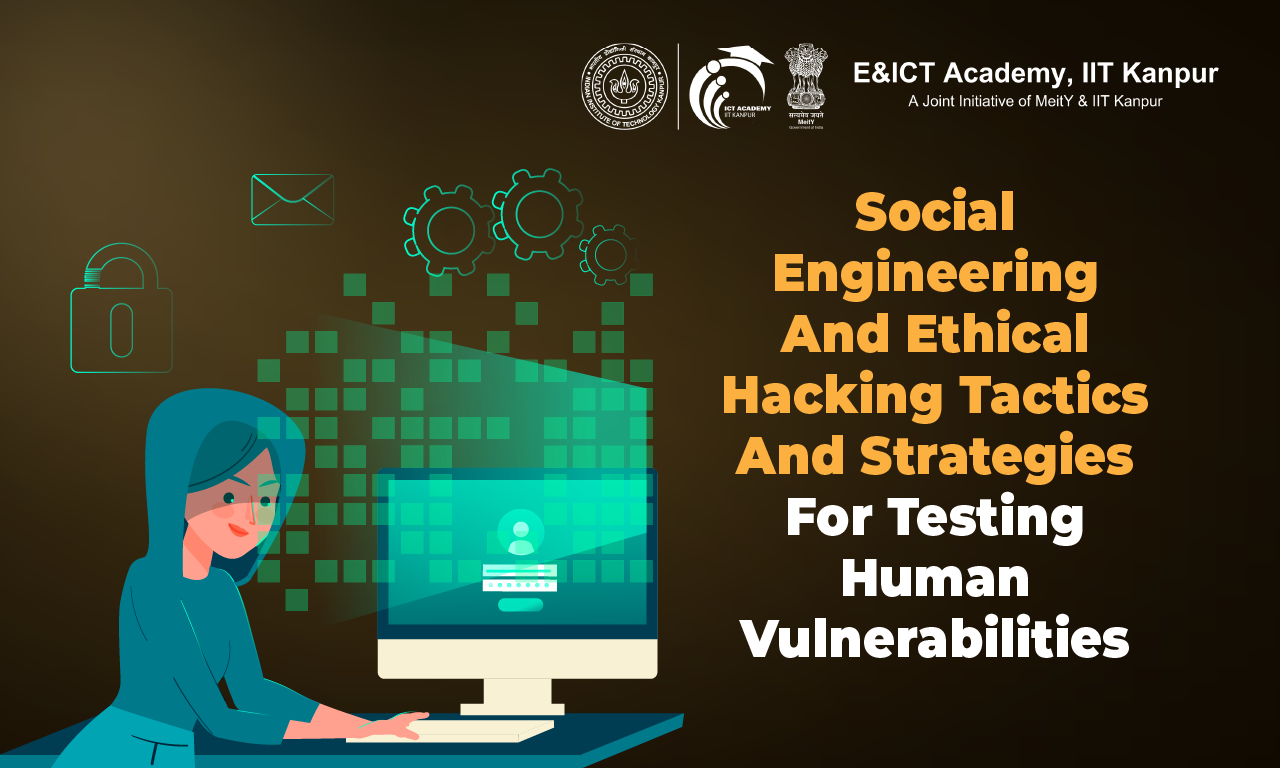Social Engineering and Ethical Hacking: Tactics and Strategies for Testing Human Vulnerabilities
- Date August 10, 2023
The necessity for effective cybersecurity measures is critical in today’s interconnected society where technology plays a major part in our daily lives. While organisations spend a lot of money securing their technical infrastructure, they frequently overlook a crucial component of security: the human element. This is when ethical hacking and social engineering are used. In this essay, we will examine the methods and approaches used by ethical hackers to test for human vulnerabilities and emphasise the significance of this practise in strengthening overall cybersecurity.
Understanding social engineering.
Social engineering is a method for coercing people into disclosing private information or taking activities that could jeopardise security. Social engineering tackles human psychology, taking advantage of people’s trust, curiosities, or sense of urgency to deceive them, in contrast to typical hacking techniques that concentrate on exploiting technical flaws. Due to people’s innate fragility and manipulative susceptibility, this practise has become more common.
Tactics of Social Engineering
Attacks involving phishing: Phishing is one of the most popular social engineering strategies and involves sending phoney emails, texts, or instant chats that look to come from a reliable source. These messages frequently include links that take the recipient to dangerous websites or ask for private data like passwords, credit card information, or social security numbers.
- Pretexting: To acquire the target’s trust, a fictitious persona or fictional scenario is created. To obtain information or gain access to restricted areas, the attacker may pose as a coworker, a client, or even a person in power.
- Baiting: Baiting is the practise of luring unsuspecting individuals with physical or digital media left in public places. For instance, a hacker can make tempting pop-up advertising that direct users to malicious websites or abandon infected USB sticks in a parking lot.
- Tailgating: By abusing their confidence or taking advantage of a brief breakdown in security measures, an unauthorised person follows an authorised person into a restricted area. This tactic takes advantage of people’s innate propensity to keep doors open for others.
Cybersecurity Ethics and Human Vulnerabilities
Penetration testing or white-hat hacking, commonly referred to as ethical hacking, comprises authorised attempts to exploit weaknesses in a system of a company in order to find flaws and suggest security improvements. Ethical hackers offer important insights into the efficacy of a company’s security procedures by testing the human factor.
The Function of Ethical Hackers
- Raising Awareness: In order to inform staff members about the strategies used by hostile actors, ethical hackers replicate actual social engineering attacks. They aid workers in comprehending the significance of abiding by security standards and exercising caution by outlining potential dangers and their possible effects.
- Identifying Weaknesses: To find the security gaps in an organisation, ethical hackers do focused social engineering operations. They assess how vulnerable workers are to social engineering tricks like phishing or pretexting. These assessments offer useful information for enhancing security awareness campaigns and putting in place appropriate safety measures.
- Education and Training: Ethical hackers are essential in creating training programmes that give staff members the knowledge and abilities they need to identify and counteract social engineering assaults. Employees can learn how to spot and report suspicious activity through conferences, seminars, and interactive exercises, reducing the likelihood of successful assaults.
Mitigating Social Engineering Attacks
- Employee Education: To inform staff members of the various social engineering strategies used by attackers, regular and thorough training programmes should be put in place. Organisations can enable their staff to act as the first line of defence against social engineering attacks by fostering a culture of security awareness.
- Forming Security Frameworks: Strong security rules should be formed, including topics like password administration, data exchange, and appropriate use of technological resources. To guarantee adherence to these standards, frequent updates and reminders should be given.
- Two-Factor Authentication (2FA): By implementing 2FA, you may increase security and make it harder for hackers to access your account without authorization. Organisations can drastically lower the chance of successful social engineering attacks by asking users to submit a second form of authentication, like a special code produced on a mobile device.
The Changing Face of Social Engineering
It’s crucial to remember that social engineering techniques are always changing. Attackers modify their strategies to take advantage of novel trends, technologies, and psychological weak points. Attackers now have access to a wealth of information thanks to the growth of social media and the extensive sharing of personal data online, which they may use to create social engineering schemes that are both highly targeted and convincing.
One such illustration is spear phishing, a subtype of phishing that targets particular people or companies. Attackers thoroughly investigate their targets, acquiring data from a variety of places like social media accounts, open databases, and business websites. An attacker might, for instance, pretend to be a coworker and fool the recipient by utilising their name, position title, and even recent initiatives or events.
Creating a Durable Defence
Organisations can use a number of tactics to strengthen their defences against social engineering attacks:
- Continuous Awareness Training: Rather than being a one-time event, cybersecurity awareness training should be a continuous practise. Inform staff members on a regular basis about the newest social engineering techniques, typical red flags, and the best ways to spot and report suspicious activity. Encourage an environment where employees feel free to voice their worries about security.
- Phishing Simulations: Run frequent phishing simulations to evaluate the success of employee training and pinpoint any gaps. These simulated attacks give organisations useful feedback and let them track their progress in reducing social engineering threats. Keep in mind that the objective is to provide employees with a learning opportunity, not to punish them for falling victim to these simulations.
- Continuous Improvement: Review and update security guidelines frequently to take into account new threats. Keep up with the most recent social engineering developments and tell your staff on them. Encourage staff input and make use of their knowledge to improve security measures.
Conclusion
In conclusion, Organisations must understand the value of assessing human vulnerabilities as part of their overall cybersecurity strategy as technology develops at a rapid pace. Employees are the weakest link in the security chain because social engineering assaults are capable of getting past even the most effective technical defences. Organisations may strengthen their defences against social engineering attacks and reduce the chance of expensive security breaches by embracing ethical hacking practises and investing in thorough employee training. Always keep in mind that cybersecurity also involves protecting the people who utilise technology.
-
₹17,698.82 (Inc. GST)
-
Sale!

₹46,020.00₹19,942.00 (Inc. GST) -
₹499.00 (Inc. GST)
-
₹999.00 (Inc. GST)
-
₹499.00 (Inc. GST)
-
₹999.00 (Inc. GST)
Previous post
The Role of Penetration Testing in Ethical Hacking: Identifying Vulnerabilities and Risks
Next post









